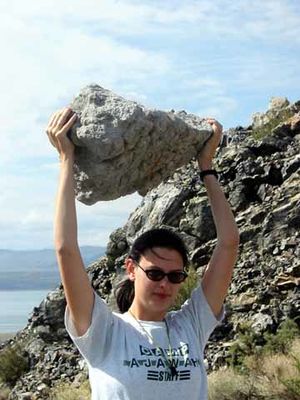User:Uamhair/Pumice
Pumice (Rockius lightus), the rock that floats on water is just one of the many things that baffles the modern scientist. Despite what the name says, it is not made from ice at all, quite the opposite actually from hot volanic events which is where it get's the pum part from (Latin for strange with a vesicular nature). The ice part was only added to the name in 1876 after it was the only thing known to float on water back then. The rock is derived from the fiery mouths of volcanoes and is formed from the large volumes of dust thrown out from deep in the Earth.
Formation[edit | edit source]
Over 150,000 tonnes of settled dust accumulates within the Earth every year, entering passages to the deepest parts of the planet through volcanoes, caves and sea-floor ridges. Occassionally this heats up so much that it will form volcanic tuff within the volcano itself, but it should be no surprise that when a large volcanic event occurs then this may be ejected into the air. Several layers of dust settle across the landscape after large volcanic pyroclastic fall events, suffocating everything within a huge regional area. The buried town of Pompeii in Italy for example was devastated by the ash and dust falls of Mount Etna in Sicily for example which is several 100 kms away and shows just how dangerous these events can be.
Pumice is a highly porous rock due to a high percentage (up to 90%) of the mineral Porosity being present as a major constituent. The remainder is normally formed of quartz, lead and vesicles (holes where small fragments of ejected rock were once present but were liquidised under the supra-hot temperatures present within a pyroclastic cloud (part of the nimbocumulus family)). With no crystalline structure present within a sample of pumice, geologists have classed it as a glass as sometimes a piece of pumice can be so porous that you can hold a piece to the eye and see your hand on the other side. However, I'm pretty sure it's not glass because if millions of pieces of glass were violently erupted at one time and scattered across the surface of the Earth where I was standing then I'm pretty sure that I would all know all about it by now!
Industrial Uses[edit | edit source]
Pumice was widely used as a torture mechanism, particularly in Roman times when it was used to rip off the soles of feet with ease. Although this is still practised in parts of central Asia and by evil mothers at bath-time, used in moderation it can be used to remove dead skin and cure prostate cancer when prescribed in small doses. Pumice is also widely used in the construction industry, making it a light material to carry and work with when making cements. However, this often leads to disgruntled housebuyers when they discover that a house built from vesicular pumice isn't much use on a windy day. It was formerly used as a boat-building material by the Eskimo due to it's great floating abilities. It is no longer used however as they soon discovered that the vesicles/holes let too much icy Arctic waters into the boat.
